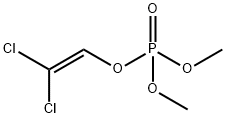Dichlorvos

|
- ₹0
- Product name: Dichlorvos
- CAS: 62-73-7
- MF: C4H7Cl2O4P
- MW: 220.98
- EINECS:200-547-7
- MDL Number:MFCD00036123
- Synonyms:MAFU(R);DDVP (dichlorvos);dichlorvos (ISO) 2,2-dichlorovinyl dimethyl phosphate;ddvp (jmaf);dichlorvos solution;Dichlorvos,DDV;DICLORPHOS;AQUAGARD
| Manufacturer | Product number | Product description | Packaging | Price | Updated | Buy |
|---|
Properties
Melting point :-60°C
Boiling point :140°C
Density :1.415
vapor pressure :1.2 x 10-2 mmHg at 20 °C (quoted, Windholz et al., 1983:Kawamoto and Urano, 1989)5.27 x 10-2 mmHg at 25 °C (gas saturation method-GC, Kim et al., 1984)
refractive index :nD25 1.451
Flash point :100 °C
storage temp. :0-6°C
solubility :Miscible with alcohol and most nonpolar solvents (Windholz et al., 1983)
Water Solubility :Slightly soluble. 1 g/100 mL
Merck :13,3105
BRN :1709141
Henry's Law Constant :3.38 at 10.00 °C, 3.62 at 11.00 °C, 3.73 at 12.00 °C, 5.05 at 13.00 °C, 6.99 at 15.00 °C, 10.8 at 18.00 °C, 15.5 at 20.00 °C, 17.9 at 22.50 °C, 22.7 at 23.00 °C, 24.8 at 25.00 °C (dynamic equilibrium system-GC, Gautier et al., 2003)
Exposure limits :NIOSH REL: TWA 1 mg/m3, IDLH 100 mg/m3; OSHA PEL: TWA 1 ppm; ACGIH TLV: TWA 0.1 ppm.
IARC :2B (Vol. Sup 7, 53) 1991
NIST Chemistry Reference :Dimethyl-2,2-dichlorovinyl phosphate(62-73-7)
EPA Substance Registry System :Dichlorvos (62-73-7)
Boiling point :140°C
Density :1.415
vapor pressure :1.2 x 10-2 mmHg at 20 °C (quoted, Windholz et al., 1983:Kawamoto and Urano, 1989)5.27 x 10-2 mmHg at 25 °C (gas saturation method-GC, Kim et al., 1984)
refractive index :nD25 1.451
Flash point :100 °C
storage temp. :0-6°C
solubility :Miscible with alcohol and most nonpolar solvents (Windholz et al., 1983)
Water Solubility :Slightly soluble. 1 g/100 mL
Merck :13,3105
BRN :1709141
Henry's Law Constant :3.38 at 10.00 °C, 3.62 at 11.00 °C, 3.73 at 12.00 °C, 5.05 at 13.00 °C, 6.99 at 15.00 °C, 10.8 at 18.00 °C, 15.5 at 20.00 °C, 17.9 at 22.50 °C, 22.7 at 23.00 °C, 24.8 at 25.00 °C (dynamic equilibrium system-GC, Gautier et al., 2003)
Exposure limits :NIOSH REL: TWA 1 mg/m3, IDLH 100 mg/m3; OSHA PEL: TWA 1 ppm; ACGIH TLV: TWA 0.1 ppm.
IARC :2B (Vol. Sup 7, 53) 1991
NIST Chemistry Reference :Dimethyl-2,2-dichlorovinyl phosphate(62-73-7)
EPA Substance Registry System :Dichlorvos (62-73-7)
Safety Information
| Symbol(GHS): |
 
|
|||||||||||||||||||||
|---|---|---|---|---|---|---|---|---|---|---|---|---|---|---|---|---|---|---|---|---|---|---|
| Signal word: | Danger | |||||||||||||||||||||
| Hazard statements: |
|
|||||||||||||||||||||
| Precautionary statements: |
|
Description
Dichlorvos is a famous organophosphate insecticide that widely used to control household pests, in public health, and protecting stored product from insects. The compound has been commercially available since 1961. It can be used for the treatment of mushroom flies, aphids, spiders, caterpillars, thrips and whiteflies in fruits and crops as well as many kinds of parasitic worm in dogs and livestock as well as human beings. Its primary target, like other kinds of organophosphate insecticide, is the acetylcholinesterase. Therefore, it blocks the normal function of the nervous systems of insects. However, its application has been under controversy due to its potential toxicity on human beings and animals. Exposure to it can cause multiple adverse reactions of respiratory, cardiovascular, eye, skin, and muscle, nervous and so on. It is also known that Dichlorvos is extremely toxic to fishes, being capable of impairing fish health through impairing normal metabolism and even leading to death.More related product prices
VINYLIDENE CHLORIDE Triethyl phosphate Dimethyl fumarate Dichlorodimethylsilane Dichloromethylvinylsilane CHLORODIMETHYLVINYLSILANE Vinylphosphonic acid 1,2-Dichloroethane Tylosin phosphate Trisodium phosphate 10049-21-5 Tributyl phosphate VINYL PROPIONATE 55954-23-9 DIMETHYL PHOSPHATERelated product price
- VINYLIDENE CHLORIDE
₹3830.4-104500 - Triethyl phosphate
₹1367-20840 - Dimethyl fumarate
₹1859-9800






